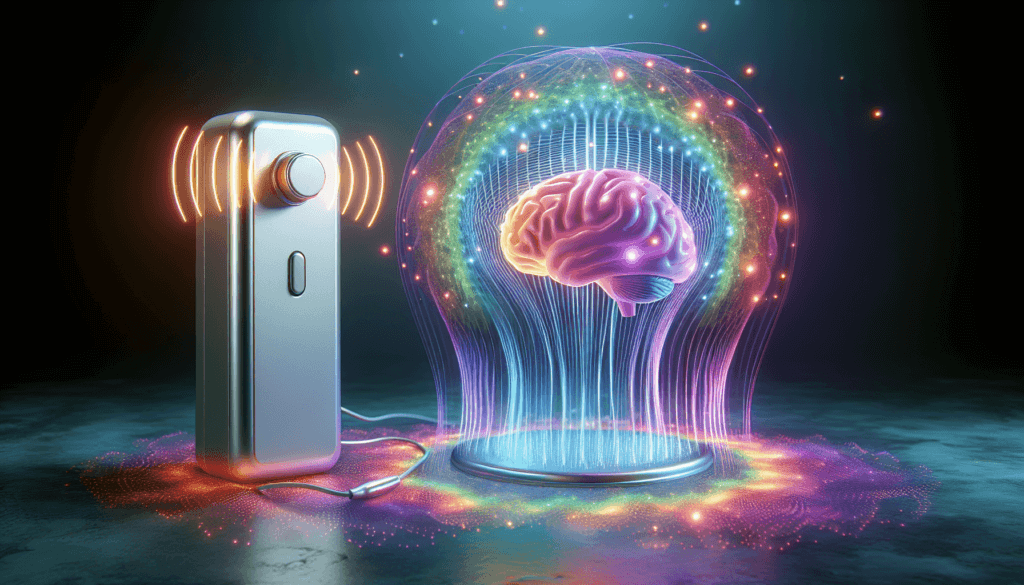Are you tired of feeling down, battling with depression day after day? Well, we have some great news for you. In this article, we will be exploring the exciting world of Pemf and its potential to help alleviate symptoms of depression. Pemf, or Pulsed Electromagnetic Field therapy, has been gaining popularity as a non-invasive and drug-free treatment option. Join us as we delve into the benefits of Pemf and discover how it might just be the solution you’ve been waiting for.
What is PEMF?
PEMF stands for Pulsed Electromagnetic Field therapy. It is a non-invasive therapeutic technique that uses electromagnetic fields to promote healing and improve overall well-being. This therapy has gained popularity in recent years as a potential alternative treatment for various health conditions, including depression.
Definition of PEMF
PEMF involves the use of electromagnetic fields that are delivered through specialized devices. These devices emit pulses of electromagnetic energy that penetrate the body and stimulate cellular activity. The pulses are of low frequency and intensity, similar to the natural magnetic fields produced by the human body.
How PEMF works
PEMF works by applying electromagnetic fields to the body, which interact with the cells and tissues. This interaction can help regulate natural electrical processes within the body, promoting cellular repair, reducing inflammation, and improving circulation. It is believed that PEMF therapy helps rebalance the body’s electromagnetic field, which may become disrupted in individuals with depression.
Types of PEMF devices
There are different types of PEMF devices available in the market, ranging from small, portable devices for personal use to larger, more powerful devices used in clinics or professional settings. Some devices are designed for localized treatment, targeting specific areas of the body, while others provide whole-body therapy. It is essential to choose a device that suits your needs and consult with a healthcare professional for guidance.
Understanding Depression
Depression is a mental health disorder characterized by persistent feelings of sadness, loss of interest in activities, changes in appetite, and difficulty sleeping. It affects millions of people worldwide and can significantly impact daily functioning and quality of life.
Definition of depression
Depression is not simply feeling blue or having a bad day; it is a clinical condition that requires medical attention. It is a mood disorder that affects the way individuals think, feel, and behave. Depression can vary in severity, ranging from mild to severe, and may have debilitating effects on an individual’s ability to function in their daily life.
Causes of depression
Depression can have multiple causes, including biological, genetic, environmental, and psychological factors. Imbalances in brain chemicals, such as neurotransmitters like serotonin, norepinephrine, and dopamine, can play a role in the onset of depression. Additionally, traumatic life events, chronic stress, and certain medical conditions can contribute to the development of depression.
Symptoms of depression
Common symptoms of depression include persistent feelings of sadness or emptiness, fatigue, loss of interest in activities once enjoyed, changes in appetite or weight, difficulty concentrating, feelings of worthlessness or guilt, insomnia or excessive sleep, and recurrent thoughts of death or suicide. It is important to note that not everyone experiences the same symptoms, and the severity and duration of symptoms can vary from person to person.
Link between PEMF and Depression
In recent years, there has been growing interest in the potential benefits of PEMF therapy for individuals with depression. Several studies have explored the effects of PEMF on depressive symptoms and the underlying mechanisms involved.
Studies on PEMF and depression
Research conducted on PEMF therapy for depression has shown promising results. A systematic review of randomized controlled trials found that PEMF therapy had a significant positive effect on depressive symptoms in individuals with major depressive disorder. Another study found that PEMF therapy was associated with a reduction in depressive symptoms in patients with treatment-resistant depression.
Mechanism behind PEMF’s effect on depression
The exact mechanism by which PEMF therapy affects depression is not fully understood. However, it is believed that PEMF therapy helps regulate brain activity and neurotransmitter levels, such as serotonin, which plays a crucial role in mood regulation. PEMF may also promote neuroplasticity, the brain’s ability to reorganize and form new neural connections, which can contribute to improved mood and overall well-being.

Benefits of PEMF for Depression
PEMF therapy offers several potential benefits for individuals with depression.
Reduced symptoms of depression
One of the main benefits of PEMF therapy for depression is its ability to reduce depressive symptoms. Many individuals who have undergone PEMF therapy report a significant improvement in mood, decreased feelings of sadness and hopelessness, and increased energy levels. PEMF therapy may help individuals manage their symptoms and regain a sense of well-being.
Improved mood and well-being
Depression can significantly impact a person’s quality of life and overall well-being. PEMF therapy has the potential to improve mood and emotional well-being by stimulating the release of endorphins, the body’s natural “feel-good” chemicals. It may also help regulate sleep patterns, reduce anxiety, and improve cognitive function.
Potential as an alternative treatment
PEMF therapy can be a valuable alternative treatment option for individuals who do not respond well to traditional antidepressant medications or who experience unwanted side effects. It can be used alone or in conjunction with other therapies, such as talk therapy or lifestyle modifications, to provide a comprehensive approach to treating depression.
How to Use PEMF for Depression
If you are considering using PEMF therapy for depression, it is essential to approach it in a safe and informed manner. Consultation with a healthcare professional, such as a psychiatrist or a qualified PEMF practitioner, is crucial to ensure appropriate use and maximize the potential benefits.
Consulting a healthcare professional
Before starting PEMF therapy, it is important to consult with a healthcare professional who has experience and knowledge in the field. They can assess your individual needs, provide guidance on the appropriate frequency and duration of sessions, and monitor your progress throughout the treatment.
Choosing the right PEMF device
When selecting a PEMF device, there are a few factors to consider. These include the type of device (portable or stationary), the intensity and frequency of the electromagnetic fields, and the specific features that may be beneficial for depression treatment. It is advisable to seek guidance from a healthcare professional or do thorough research to ensure the chosen device meets your needs.
Frequency and duration of PEMF sessions
The frequency and duration of PEMF sessions can vary depending on individual circumstances and the specific PEMF device being used. Healthcare professionals will typically provide recommendations based on the severity of your depression, your overall health, and your response to treatment. It is important to follow these recommendations and not exceed the recommended duration or frequency.
Safety and Considerations
While PEMF therapy is generally considered safe, there are some considerations to keep in mind, especially for certain individuals or in specific situations.
Potential side effects of PEMF
PEMF therapy is considered safe and non-invasive, with minimal side effects reported. However, some individuals may experience mild discomfort during or after the sessions, such as slight tingling or a sense of warmth in the treated area. These sensations are usually temporary and resolve quickly.
Precautions for specific individuals
Certain individuals may need to take additional precautions or seek medical advice before undergoing PEMF therapy. This includes individuals with implanted medical devices, such as pacemakers or infusion pumps, pregnant women, and individuals with epilepsy or a history of seizures. It is crucial to inform your healthcare professional about any pre-existing conditions or concerns before starting PEMF therapy.
Combining PEMF with other treatments
PEMF therapy can be used as an adjunct to other treatments for depression, such as medication or talk therapy. It is important to inform your healthcare professionals about all the treatments you are undergoing, as they can work together to develop a comprehensive and individualized treatment plan for your depression.
Testimonials and Personal Experiences
There are numerous stories and testimonials from individuals who have used PEMF therapy for depression and experienced positive outcomes. These personal experiences highlight the potential benefits of PEMF therapy and its impact on their quality of life.
Stories of individuals who have used PEMF for depression
Individuals who have used PEMF therapy for depression often describe a significant improvement in their mood and overall well-being. They report feeling more energized, experiencing fewer depressive symptoms, and regaining motivation to engage in activities they once enjoyed. These personal stories serve as a source of hope and inspiration for others considering or undergoing PEMF therapy.
Success stories and positive outcomes
Success stories involving PEMF therapy for depression demonstrate the potential of this treatment as an effective intervention. Individuals have reported a reduction in depressive symptoms, improved sleep patterns, increased focus and concentration, and enhanced emotional stability. These positive outcomes emphasize the importance of exploring different treatment options for depression.
Current Research on PEMF and Depression
Ongoing research on PEMF therapy for depression is increasing our understanding of its effectiveness and potential mechanisms of action.
Latest studies and findings
Recent studies have investigated the use of PEMF therapy for depression and have reported encouraging findings. Some studies have shown improvements in depressive symptoms and increased response rates in individuals receiving PEMF therapy compared to a control group. Continued research is essential to validate these findings and refine the understanding of PEMF’s role in depression treatment.
Future directions for research
Future research on PEMF therapy for depression should focus on elucidating the specific mechanisms involved in its therapeutic effects. Additionally, identifying optimal treatment protocols, assessing long-term outcomes, and exploring the potential of combining PEMF therapy with other treatment modalities could provide valuable insights for improving depression management.
Limitations and Criticisms
While PEMF therapy shows promise as a potential treatment for depression, there are limitations and criticisms that need to be considered.
Controversies surrounding PEMF for depression
Some controversies exist surrounding the use of PEMF therapy for depression. Skeptics argue that the evidence supporting its effectiveness is limited and that more high-quality clinical trials are needed to establish its efficacy definitively. Additionally, the lack of standardized treatment protocols and the wide variety of available PEMF devices can make it challenging to draw concrete conclusions.
Critiques of existing studies
Critics have raised concerns about the methodologies and limitations of existing studies on PEMF therapy for depression. Some studies have had small sample sizes or short follow-up periods, making it difficult to establish the long-term effects of the therapy. Additionally, the potential for bias or conflicts of interest may influence the results of some studies. These critiques emphasize the need for further research and more robust study designs.
Conclusion
PEMF therapy holds promise as a potential alternative treatment for individuals with depression. The interaction of electromagnetic fields with the body may help regulate brain activity, neurotransmitter levels, and promote cellular repair, leading to reduced depressive symptoms and improved overall well-being. It is crucial to approach PEMF therapy in consultation with a healthcare professional, choose the right device, and follow appropriate frequency and duration guidelines. While further research is needed to fully understand the mechanisms and optimize treatment protocols, PEMF therapy offers hope and encouragement for individuals seeking alternative options for managing their depression.


